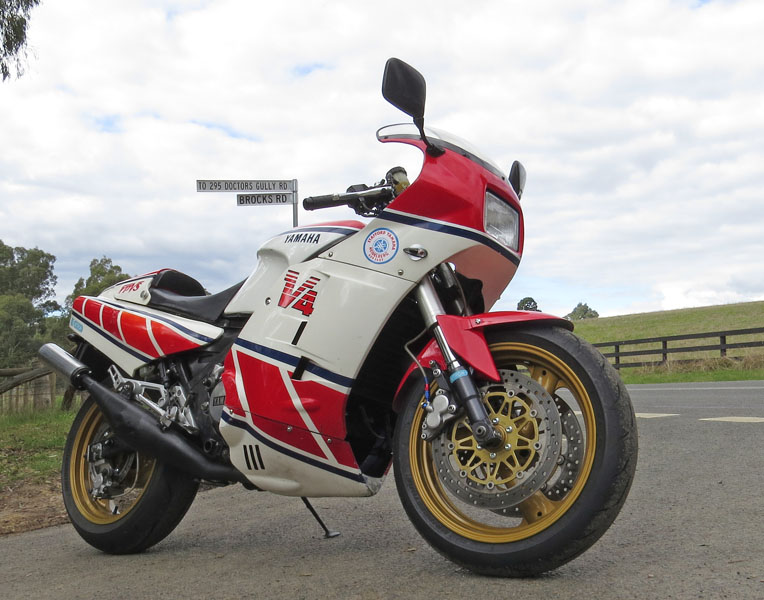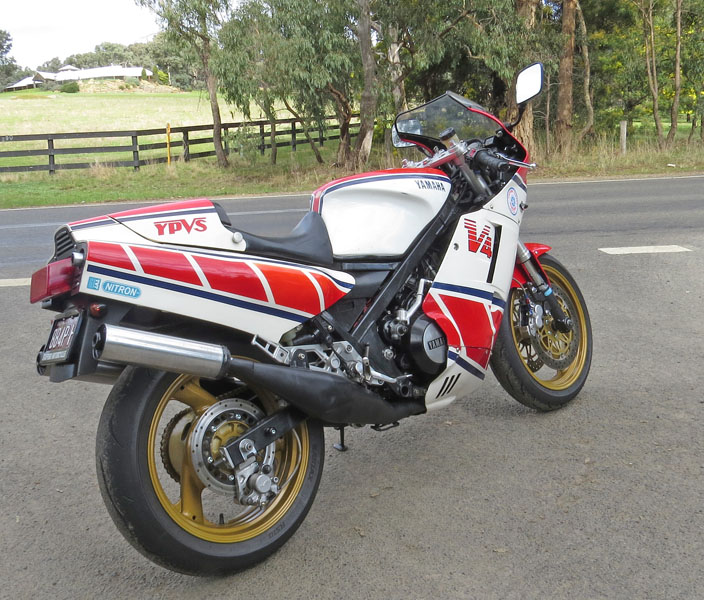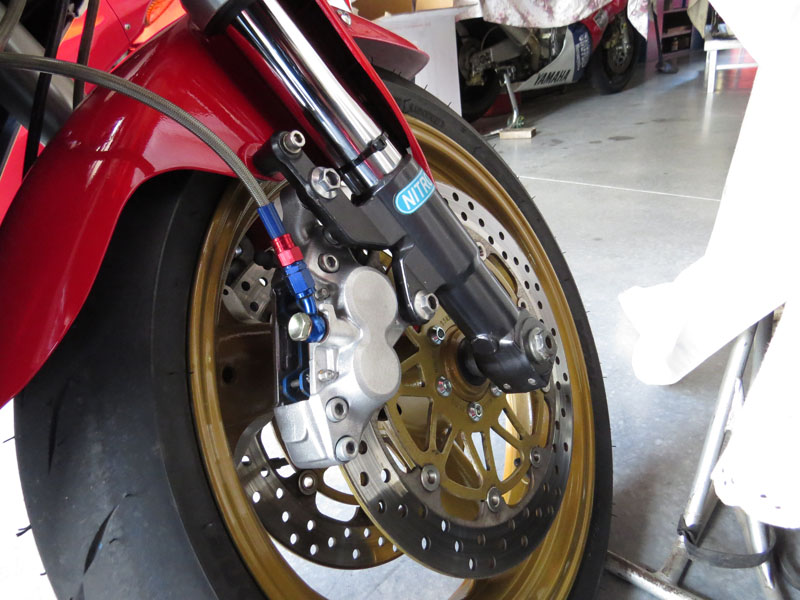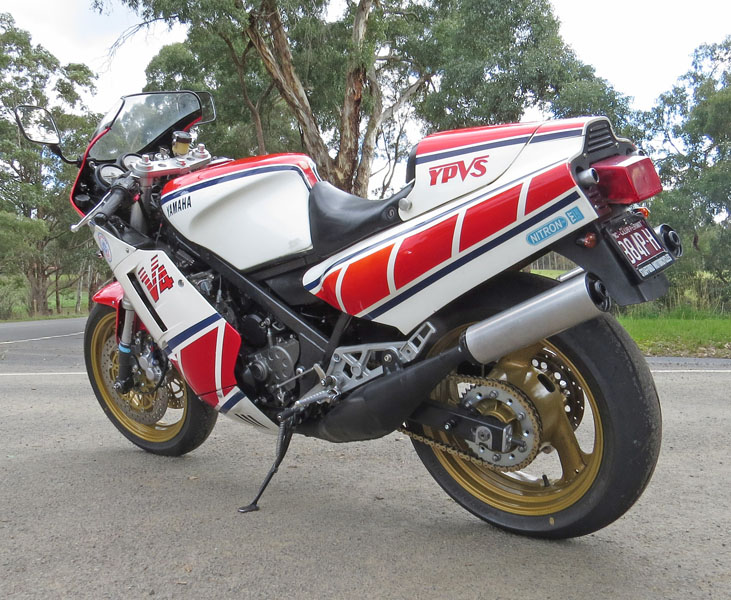Motorcycle Investor mag
Subscribe to our free email news

Sleeper Stroker
(August 2020)
by Guy 'Guido' Allen

Restomod RZ500 rides better than new
If you get to know Don Stafford, long-time racer, race bike engineer and former Yamaha dealer, you’ll soon learn there are two things he reckons he can’t or would prefer not to do: restore motorcycles and build road bikes. He’s half right. We’ve yet to see him tackle an end-to-end resto.
As for road bikes, I beg to differ. A warmed up MT-01 he
created several years ago as an Over Racing promo platform
is my favourite example – fast, loud and sharp. And now
this. It’s a 1984 Yamaha RZ500 with a twist.
Let’s wander back into 1983-84 to get a handle on the
thing. Two-stroke motorcycles were still mainstream. The
likes of the Yamaha RZ250/350 and Suzuki RG250 series were
very much alive - though there was no question
four-strokes had comprehensively taken over as dominant
road-going performance motorcycles.
However the hero international race series, the 500cc
grands prix, was still two-stroke world. For Yamaha, Kenny
Roberts was still King Kenny and for the 1983 season was
riding a second-gen V-four. While upstart Freddie Spencer
was to win the title for Honda, Yamaha was well underway
with its plans to release a GP replica for the road.
The rumours started in late 1983 and were rife by early 1984. This was serious. You have to remember that this, at the time, was a one-of-a-kind announcement: you will soon be able to buy a proper grand prix replica motorcycle. Same engine capacity, same configuration, similar looks, and fast.


Though nominally listed at $5200, by the time the first examples arrived here in the third quarter of 1984 – and it was never big volumes – they were selling at a significant premium.
With a claimed 88 horses (64kW) for a dry weight of 180 kilos, they had serious power for the day in a diminutive and light package. Not since Honda’s 750-Four, or Kawasaki’s first-gen Z900, had four exhaust pipes generated such excitement. And on this bike, they exited on two decks.
Maybe four-strokes were taking over on the street, but when it came to the fabled Castrol 6-Hour production race of 1984 (see sidebar), RZ500s – though nothing else quite like them had existed before – were billed to fill a third of the starting grid. And they won.
You need to look through the lens of that background to understand why people still get excited about these things. Even without that knowledge, a cackling four-pot stroker stands out on the road these days as something a little mad.
Now here’s the funny thing: in just a few years after the initial excitement, RZ500s dropped off the scene. In truth, they weren’t great road bikes. By far their biggest issue was they handled poorly if not kept in top shape.
As a result, they quickly developed a reputation for being unstable – not entirely undeserved – and the thought of dealing with what was then a complex and sophisticated two-stroke as it aged was too much for the market. Values plummeted.

Their fortunes have changed over the last five years, and they’re now collectible. However that’s not what drove Don to buy his. “My son Craig bought one, and I said ‘I hope you enjoy it’.
“He said, ‘Dad, it’s fantastic!’ So I was watching one for sale online and I rang the guy. We got talking and it turns out he was a rep who came to my shop over the years.
“So I went down to Geelong and bought it. I didn’t even ride it.”
What happens next will make a whole lot more sense when you understand that Don has built a series of very fast race bikes over the years, most recently some slick Period 6 FZR1000s.

“I was thinking about making it the way I wanted it. There was a set of FZR1000 wheels sitting there, that’s how it started.
“And there was a set of upside-down forks from one of the race bikes I’d dismantled…”
You can see where this is going. The RZ started with a 16-inch front and 18-inch rear wheel, with 120 and 130 section tyres, plus early eighties suspension and brakes. Even by the standards of the day – particularly with a short wheelbase – it wasn’t a recipe for great handling.

Now it’s wearing what is effectively a second-gen FZR1000 undercarriage: 17-inch wheels both ends with a giant 180 section rear, four-spotter front brakes and discs, early R6 rear brake, a USD fork and a custom-made Nitron rear shock. The latter is about a centimeter longer than stock, while the overall effect has the bike sitting higher, with a more-tail-up stance.
That must have been a challenge to squeeze in? Not as much as you think. Incredibly, the FZR triple trees bolted straight in. Don confesses to considering getting something custom-built, but dismissed it.
There were two fitting issues. Up front, the fairing brackets had to be spread with spacers to make clearance for the wider triple trees, though the fairing itself was left untouched.
Out back the rear tyre threatened to rub on a right-hand exhaust. That could have been bad news, but Don was pleasantly surprised to discover the exhaust was a casing over an expansion chamber – so he was able to cut and shut the casing without hurting the critical parts.
He had some reservations about using the FZR wheels and considered fitting some exotic Marchenisis. Why? “The FZR rear wheel is very heavy. With no sprocket it weighs 18 kilos - that’s a lot of weight to control. One of our race wheels is 11-12!” In the end, his head ruled his heart. “It is a road bike,” he points out.

Finishing off the package is a set of R6 handlebars and grips, which fit under the top triple tree, rather than over as they would have on a stock example. Though that sounds otherwise, it’s comfortable and far from being an extreme lean-forward stance.
One thing I love is that Don has stuck to his anti-restoration schtick by leaving the cosmetics alone. It has some minor rubs and scrapes and battle scars from the years, which he is perfectly content to leave. A nice touch is the retro shop stickers he added, with old seven digit phone numbers.
I pinched the RZ for a brief play in the nearby hills. Don booted it into life with no fuss and kept it running while I strapped on a lid. Right, then into the saddle and give it enough revs for the tight turn out of his yard, without bogging it down. Juggle the throttle on the way up the street, so it runs clean and let it warm up. Two-strokes are different, not welcoming the blind indifference that a four-stroke with CV carbs (or injection) will tolerate.
As the road clears, you can feed in more and the cackle becomes a howl. God, that’s a sexy note.
The RZ is one of the more flexible powerplants of its type, but the real action happens from 7000rpm to 9500 when it’s making max horses. It’s a brief and hackle-raising window of opportunity. Wonderful.

What I was most dreading was the handling. The last time I rode an RZ500 was when they were new, 34-ish years ago, and the two examples I threw a leg over were exciting but didn’t fill you with confidence.
This one? Benign and surprisingly modern. Cackle and howling noises aside, you could have been on any good road bike built in the last 20 years. Don’s handling mods have transformed it, without ruining the looks.
He’s done nothing to the engine, and reckons the last time he did a crank rebuild on one it had 80,000 road kilometres on the clock. This example is just fine.
The more you ride it, the more you realise it’s picked up a huge amount of performance by just steering straight and handling properly. Really nice.
I roll back into his shed. Despite the decades of experience that prove he knows far more than me about this stuff, he’s still concerned. “Was it alright?” he asks.
“If you decide to sell it, call me first,” was the response…
See the contemporary road test from
Classic Two Wheels
***

Pic: Yamaha News in 1984 celebrating the RZ500's win in the Castrol 6-Hour
Castrol Six-Hour Winner
Once upon a time…or that’s how the story should start, I
guess. There was a fabulous production motorcycle race
called the Castrol 6-Hour, run by the Willoughby Club out
of Sydney. It ran from 1970 through to 1987.
Back in the early days, it was broadcast by the ABC with
enthusiasts such as Will Hagon and John Smailes doing
commentary. This was a major event. It started as an
extraordinary endurance test around Amaroo Park, and then
moved to Oran Park for the final three years.
It became a hugely influential challenge, much like the
(then) Bathurst 500/1000 for cars. The rules were intended
to highlight showroom motorcycles, running street tyres.
Motorcycle manufacturers fought over honours and, for several years, it was as much about the tyres as it was the motorcycles. If Pirelli won, for example, it shouted it from the rooftops and sold shiploads of Phantoms as a result.
In 1984, the field was extraordinary and read like a who’s who of fast riders. Names like Gardner, Phillis, Feeney, Baldwin and Merkel (yep, the Americans), Dowson, Pace, Willing, Campbell, Oldfield, Heyes, Gall, Chivas, Holden, Sayle, Middlemiss…where do you stop?
Three motorcycles dominated the entries: Honda VF1000R, Kawasaki GPz900R and Yamaha RZ500. Eleven of the 30 provisional entries were RZs.
It was the last-minute pairing of Michael Dowson and Richard Scott who won, on an RZ500 backed by then Dunlop importer Emerson Sport. The result was controversial, as Wayne Gardner and John Pace were on the same lap on their VF1000R, but the race was cut short to fit TV commitments.
Both bikes were on vapour when it came to fuel and some felt the Honda might have won if the extra couple of laps had been run.
Who came third? Neil Chivas and Robert Holden on (of all
things) a Suzuki Katana 750, four laps down.
(Recommended reading: The Castrol Six Hour Production
Race, authored by Jim Scaysbrook and published by
Rennicks. Motociclo has them for sale.)

SPECS:
Yamaha RZ500/RD500 (standard)
ENGINE:
TYPE: Liquid-cooled, 50-degree V-four red valve two-stroke
with YPVS (powervalve)
CAPACITY: 499cc
BORE & STROKE: 56.4 x 50mm
COMPRESSION RATIO: 6.6:1
FUEL SYSTEM: 4 x 26mm Mikuni
TRANSMISSION:
TYPE: Six-speed, constant-mesh,
FINAL DRIVE: Chain
CHASSIS & RUNNING GEAR:
FRAME TYPE: Perimeter square-section steel
FRONT SUSPENSION: Conventional 37mm telescopic fork,
air-assist, spring preload adjustable, anti-dive
REAR SUSPENSION: Monoshock with spring preload and rebound
damping adjustment
FRONT BRAKE: 267mm discs with two-piston calipers
REAR BRAKE: 245mm disc with two-piston caliper
DIMENSIONS & CAPACITIES:
DRY/WET WEIGHT: 180/199kg
SEAT HEIGHT: 780mm
WHEELBASE: 1375mm
FUEL CAPACITY: 22lt
WHEELS & TYRES:
FRONT: Cast aluminium 120/80-16
REAR: Cast aluminium 130/80-18
PERFORMANCE:
POWER: 64kW @ 9500rpm
TORQUE: 68Nm @ 8500rpm
OTHER STUFF:
PRICE NEW: $5200 plus ORC
-------------------------------------------------
Produced by AllMoto abn 61 400 694 722
Privacy: we do not collect cookies or any other data.

Archives
Contact



